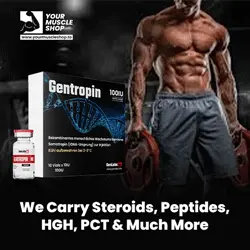Steroid hormones have to transmit their message in the cell to a receiver, the receptor, and this receptor has to carry this message further. Thus testosterone [TABLE="align: right"]
<tbody>[TR]
[TD]<ins style="margin: 0px; padding: 0px; border: currentColor; width: 120px; height: 600px; display: inline-table; visibility: visible; position: relative; background-color: transparent;" id="aswift_0_expand"><ins style="margin: 0px; padding: 0px; border: currentColor; width: 120px; height: 600px; display: block; visibility: visible; position: relative; background-color: transparent;" id="aswift_0_anchor"><iframe style="left: 0px; top: 0px; position: absolute;" id="aswift_0" height="600" marginHeight="0" frameBorder="0" width="120" allowTransparency="" name="aswift_0" marginWidth="0" scrolling="no" allowfullscreen="true"></iframe></ins></ins>[/TD]
[/TR]
</tbody>[/TABLE]
has to find the androgen receptor and it has to form a complex with this receptor. This testosterone-androgen receptor complex has to tell the DNA in the genes that it has to start protein synthesis for more muscles.
The androgen receptor and by far the biggest part of the muscles are proteins. Also enzymes, organs, tendons, skin, nails and hair consist of proteins. It is therefore good to explain first how proteins look like on a molecular level. It is also on this molecular level that the interaction between the ligand, testosterone, and the androgen receptor has to take place.
Proteins are biopolymers. A polymer is a giant molecule, assembled from many smaller molecules, the monomers. The monomers of proteins are the amino acids. In our body proteins are constructed from 20 different amino acids. These amino acids all have an amino group (NH[SUB]2[/SUB]-group) and a carboxylic acid group (COOH-group) in common. In between these two groups there is one additional C-atom, which carries the side chain R. This R-group (rest-group) is different for all 20 amino acids.
In a protein the carboxylic acid group of one amino acid is connected to the amino group of the next one with a so called amide or peptide bond. In this way many amino acids are linked to a long chain to form one large molecule (see Figure 1). When a limited number of amino acids (10-100) is linked, the molecule is called a peptide. When a larger number of amino acids are bound together it is called a protein. There is no sharp boundary between these two groups.
The peptide bonds in the chain of amino acids are of course important, because they keep the molecule together, but also the side chains of the amino acids are important. These side chains contain all kinds of so called functional groups and these functional groups give each amino acid its own characteristic properties and function. A subdivision of amino acids is made, based on the chemical characteristics of their side chains. In this way we can distinguish amino acid side chains with apolar alkyl groups, sulphur containing groups, hydroxyl groups, basic nitrogen containing groups, carboxylic acid groups and amides.
All 20 amino acids in proteins, with their names and their official short names, are depicted in figure 2. They are grouped together according to the chemical characteristics of their side chain.
In each protein the quantity of each individual amino acid may vary to a large extend, and also the sequence of the amino acids in proteins can vary endlessly. This means that with these 20 amino acids an unlimited number of different proteins can be constructed.
When a protein is constructed from individual amino acids a chain is formed that is kept together by the peptide bonds. These peptide bonds and also the side chains of the amino acids can also interact with each other to provide for a second type of bonding.
This second type of interaction between the peptide bonds and between the side chains of the amino acids is much weaker than the strength of normal bonds. However, all these weak interactions together make that the long chain of amino acids in a protein is folded in a characteristic way, which is unique for each protein. This folding is a bit comparable with the folding of a thread of wool that is kneaded to a loose ball.
It is useful to have a closer look to the interactions between side chains of amino acids that cause the characteristic folding of a chain of amino acids to the protein as it is found in Nature. Also the shape of the pocket in the androgen receptor is formed as a consequence of this folding. At the inside of the pocket in the androgen receptor 18 amino acids are located and interactions of the side chains of these amino acids with the steroid molecule that has to fit in this pocket, are of utmost importance. Ultimately all these interactions together are responsible for the formation of the testosterone-androgen receptor complex so that it can execute its function.
- - - Updated - - -
sorry about the gaps must be something Im doing will try to fix it
<tbody>[TR]
[TD]<ins style="margin: 0px; padding: 0px; border: currentColor; width: 120px; height: 600px; display: inline-table; visibility: visible; position: relative; background-color: transparent;" id="aswift_0_expand"><ins style="margin: 0px; padding: 0px; border: currentColor; width: 120px; height: 600px; display: block; visibility: visible; position: relative; background-color: transparent;" id="aswift_0_anchor"><iframe style="left: 0px; top: 0px; position: absolute;" id="aswift_0" height="600" marginHeight="0" frameBorder="0" width="120" allowTransparency="" name="aswift_0" marginWidth="0" scrolling="no" allowfullscreen="true"></iframe></ins></ins>[/TD]
[/TR]
</tbody>[/TABLE]
has to find the androgen receptor and it has to form a complex with this receptor. This testosterone-androgen receptor complex has to tell the DNA in the genes that it has to start protein synthesis for more muscles.
The androgen receptor and by far the biggest part of the muscles are proteins. Also enzymes, organs, tendons, skin, nails and hair consist of proteins. It is therefore good to explain first how proteins look like on a molecular level. It is also on this molecular level that the interaction between the ligand, testosterone, and the androgen receptor has to take place.
Proteins are biopolymers. A polymer is a giant molecule, assembled from many smaller molecules, the monomers. The monomers of proteins are the amino acids. In our body proteins are constructed from 20 different amino acids. These amino acids all have an amino group (NH[SUB]2[/SUB]-group) and a carboxylic acid group (COOH-group) in common. In between these two groups there is one additional C-atom, which carries the side chain R. This R-group (rest-group) is different for all 20 amino acids.
In a protein the carboxylic acid group of one amino acid is connected to the amino group of the next one with a so called amide or peptide bond. In this way many amino acids are linked to a long chain to form one large molecule (see Figure 1). When a limited number of amino acids (10-100) is linked, the molecule is called a peptide. When a larger number of amino acids are bound together it is called a protein. There is no sharp boundary between these two groups.
The peptide bonds in the chain of amino acids are of course important, because they keep the molecule together, but also the side chains of the amino acids are important. These side chains contain all kinds of so called functional groups and these functional groups give each amino acid its own characteristic properties and function. A subdivision of amino acids is made, based on the chemical characteristics of their side chains. In this way we can distinguish amino acid side chains with apolar alkyl groups, sulphur containing groups, hydroxyl groups, basic nitrogen containing groups, carboxylic acid groups and amides.
All 20 amino acids in proteins, with their names and their official short names, are depicted in figure 2. They are grouped together according to the chemical characteristics of their side chain.
In each protein the quantity of each individual amino acid may vary to a large extend, and also the sequence of the amino acids in proteins can vary endlessly. This means that with these 20 amino acids an unlimited number of different proteins can be constructed.
When a protein is constructed from individual amino acids a chain is formed that is kept together by the peptide bonds. These peptide bonds and also the side chains of the amino acids can also interact with each other to provide for a second type of bonding.
This second type of interaction between the peptide bonds and between the side chains of the amino acids is much weaker than the strength of normal bonds. However, all these weak interactions together make that the long chain of amino acids in a protein is folded in a characteristic way, which is unique for each protein. This folding is a bit comparable with the folding of a thread of wool that is kneaded to a loose ball.
It is useful to have a closer look to the interactions between side chains of amino acids that cause the characteristic folding of a chain of amino acids to the protein as it is found in Nature. Also the shape of the pocket in the androgen receptor is formed as a consequence of this folding. At the inside of the pocket in the androgen receptor 18 amino acids are located and interactions of the side chains of these amino acids with the steroid molecule that has to fit in this pocket, are of utmost importance. Ultimately all these interactions together are responsible for the formation of the testosterone-androgen receptor complex so that it can execute its function.
- - - Updated - - -
sorry about the gaps must be something Im doing will try to fix it









